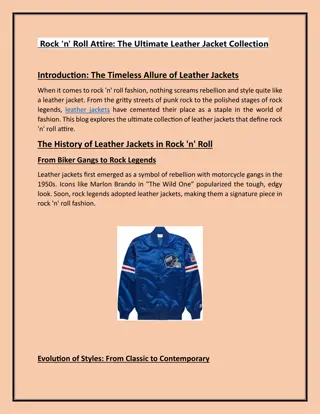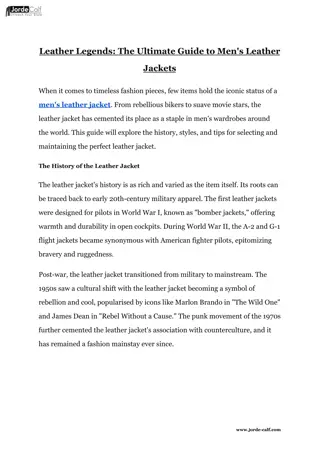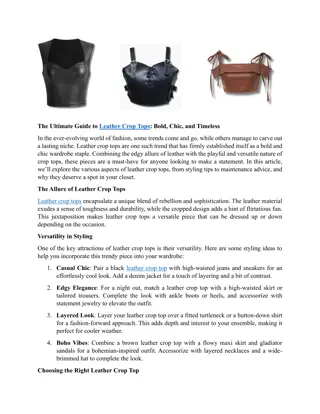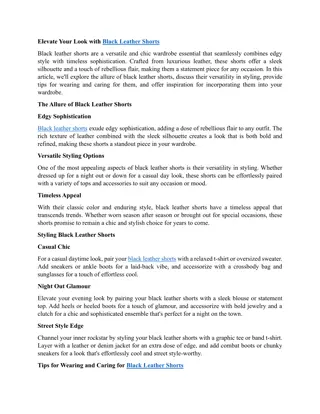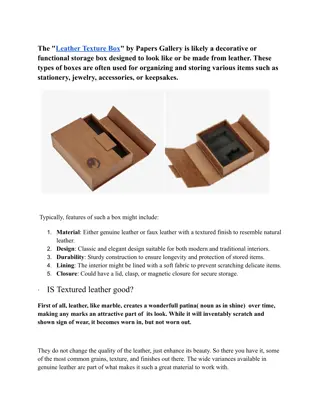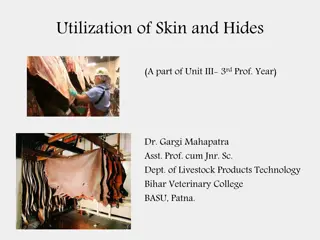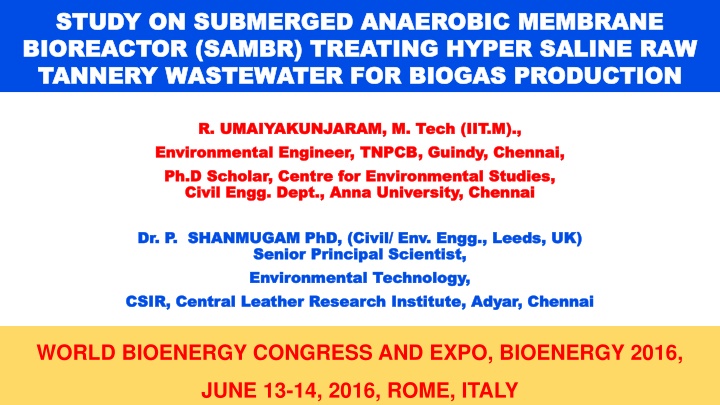
Study on Submerged Anaerobic Membrane Bioreactor for Biogas Production from Tannery Wastewater
Understand the advanced treatment process using a Submerged Anaerobic Membrane Bioreactor (SAMBR) for hyper-saline raw tannery wastewater to enhance biogas production. Explore the benefits of SAMBR in achieving high-quality permeate, efficient removal of total suspended solids, and enhanced methanogenesis. Discover the features of SAMBR for handling hyper-saline raw suspended wastewater, including high biomass levels, bio-granulation, and uniform biogas production.
Download Presentation

Please find below an Image/Link to download the presentation.
The content on the website is provided AS IS for your information and personal use only. It may not be sold, licensed, or shared on other websites without obtaining consent from the author. If you encounter any issues during the download, it is possible that the publisher has removed the file from their server.
You are allowed to download the files provided on this website for personal or commercial use, subject to the condition that they are used lawfully. All files are the property of their respective owners.
The content on the website is provided AS IS for your information and personal use only. It may not be sold, licensed, or shared on other websites without obtaining consent from the author.
E N D
Presentation Transcript
STUDY ON SUBMERGED ANAEROBIC MEMBRANE STUDY ON SUBMERGED ANAEROBIC MEMBRANE BIOREACTOR (SAMBR) TREATING HYPER SALINE RAW BIOREACTOR (SAMBR) TREATING HYPER SALINE RAW TANNERY WASTEWATER FOR BIOGAS PRODUCTION TANNERY WASTEWATER FOR BIOGAS PRODUCTION R. UMAIYAKUNJARAM, M. Tech (IIT.M R. UMAIYAKUNJARAM, M. Tech (IIT.M)., Environmental Engineer, TNPCB, Environmental Engineer, TNPCB, Guindy Ph.D Ph.D Scholar, Centre for Environmental Studies, Scholar, Centre for Environmental Studies, Civil Civil Engg Engg. Dept., Anna University, Chennai . Dept., Anna University, Chennai )., Guindy, Chennai, , Chennai, Dr Dr. P. . P. SHANMUGAM PhD, (Civil SHANMUGAM PhD, (Civil/ / Env Senior Principal Scientist, Senior Principal Scientist, Environmental Technology, Environmental Technology, CSIR, Central Leather Research Institute, CSIR, Central Leather Research Institute, Adyar Env. . Engg Engg., Leeds, UK) ., Leeds, UK) Adyar, Chennai , Chennai WORLD BIOENERGY CONGRESS AND EXPO, BIOENERGY 2016, JUNE 13-14, 2016, ROME, ITALY
BACKGROUND OF STUDY BACKGROUND OF STUDY The The aeration aeration process 60 60% % of of operation operation cost Alternatively, Alternatively, Upflow adopted adopted to to treat But, But, it it became became unsuccessful tannery tannery wastewater wastewater due However, However, the the submerged (SAMBR) (SAMBR) has has many a) a) SAMBR SAMBR operated operated at hydrolysis hydrolysis and for for TSS TSS removal removal using and and secondary secondary clariflocculator b) b) Decouples Decouples the the HRT c) c) Achieves Achieves quality quality permeate, process in cost in Upflow Anaerobic Anaerobic Sludge treat soluble soluble tannery tannery effluent unsuccessful for due to to poor submerged anaerobic many advantages advantages over at high high biomass and methanogenesis methanogenesis of using chemical chemical clariflocculator clariflocculator. . HRT and and SRT SRT permeate, may may be in Activated Activated sludge in CETPs CETPs. . sludge process process consumes consumes Sludge Blanket Blanket reactor effluent to to produce for hyper hyper saline saline high poor bio bio- -granulation granulation. . anaerobic membrane membrane bioreactor over UASB UASB reactors reactors; ; biomass enhances enhances high of CODp CODp that that eliminates eliminates the clariflocculator and reactor was produce biogas high suspended suspended was biogas. . bioreactor high degree degree of the need and further further aerator of need aerator be suitable suitable for for direct direct RO RO
FEATURES OF SAMBR FOR HYPER SALINE RAW SUSPENDED FEATURES OF SAMBR FOR HYPER SALINE RAW SUSPENDED WASTEWATER WASTEWATER SAMBR SAMBR can High High biomass biomass level mg mg. . L L- -1 1 in methanogenesis methanogenesis High High MLVSS/MLSS MLVSS/MLSS (F/M) Expected Expected to to achieve Bio Bio- -granulation granulation degradation degradation throughout can replace replace ASP level in in ASP ASP and ASP and in SAMBR SAMBR ( (12 and enhances enhances rapid and UASB UASB 12- -20 20 g g. . VSS/L) VSS/L) unlike rapid hydrolysis hydrolysis and unlike 4000 4000 and (F/M) is more biogas doesn t doesn t throughout SAMBR is achieved achieved biogas require, require, SAMBR achieve more therefore therefore uniform uniform
AIM & OBJECTIVE OF THE STUDY AIM & OBJECTIVE OF THE STUDY To To utilize utilize the the the anaerobic anaerobic membrane and and space space for for physio treatment treatment. . To To achieve achieve the Soluble Soluble COD COD and To To minimize minimize the to to avoid avoid pump pump based external external impeller impeller mixing To To achieve achieve mass mass GLS/scum the high high suspended suspended raw membrane bioreactor, physio- -chemical chemical units raw tannery tannery wastewater bioreactor, thus, thus, to units in in the wastewater for to save save the the cost the wastewater wastewater for cost the hydrolysis hydrolysis of and to to enhance enhance the the fouling fouling on based slurry mixing. . GLS/scum foam of high high Particulate Particulate COD the OLR OLR in in SAMBR SAMBR. . on the the membrane membrane by slurry and and impeller impeller mixing COD into into by biogas biogas mixing mixing and mixing and foam break break using using biogas biogas mixing mixing
SCOPE OF THE STUDY SCOPE OF THE STUDY To reduce the chemical and biological sludge production To reduce the chemical and biological sludge production To eliminate the chemical and aerator cost To eliminate the chemical and aerator cost To maximize the biogas yield per gram of To maximize the biogas yield per gram of COD CODremoved removed To prevent the membrane fouling by gas mixing and To prevent the membrane fouling by gas mixing and expected process benefit expected process benefit
CRITICAL REVIEW OF LITERATURE CRITICAL REVIEW OF LITERATURE REMARKS REMARKS AUTHORS AUTHORS WASTEWATER WASTEWATER MEMBRANE MEMBRANE SRT SRT COD CODremoved removed BIOGAS BIOGAS Textile Textile waste water; water; * *reactive orange reactive orange 16 16 ( (azo azo dye) dye) waste Flat sheet Flat sheet ultrafiltration ultrafiltration membrane membrane (0.4 m) (0.4 m) 55 55% (at VFA % (at VFA accumulated accumulated stage) 95% stage) 95% (initial stage) (initial stage) 0.32 0.32- -0.34 L 0.34 L CH CH4 4/g COD CODremoved removed Spagni Spagni, et al., (2012) al., (2012) , et Hyper saline Hyper saline wastewater wastewater 150 150- -200 days 200 days /g Stucky Stucky & Vyrides Vyrides (2008) (2008) & Saline sewage Saline sewage under fluctuating under fluctuating concentration concentration Flat sheet Flat sheet membrane membrane (0.4 m) (0.4 m) Flat sheet micro Flat sheet micro filtration filtration membrane (PVDF) membrane (PVDF) 99% DOC 99% DOC removal removal at at 8 8 hour hour HRT Hyper saline Hyper saline wastewater wastewater - - 250 days 250 days HRT Lin Lin et al., et al., (2009) (2009) Kraft evaporator Kraft evaporator condensate water condensate water 0.35 0.35 L CH COD CODremoved removed L CH4 4/g /g No hyper saline No hyper saline wastewater wastewater 230 days 230 days 97 97- -99% 99% 40 days 40 days - - municipal, municipal, 160 days 160 days - - industrial industrial 93 93- -95% for 95% for Municipal, Municipal, 97 97- -99% for 99% for Industrial Industrial Krzeminski Krzeminski, , et et al., al., ( (2015) 2015) Municipal and Municipal and industrial waste industrial waste water water Flat sheet Flat sheet membrane membrane (0.08 m) (0.08 m) No hyper saline No hyper saline wastewater wastewater - - Thermo Thermo- - mechanical mechanical pulping white pulping white water water Lin Lin et al., et al., (2011) (2011) Flat sheet micro Flat sheet micro filtration (PVDF) filtration (PVDF) No hyper saline No hyper saline wastewater wastewater - - 280 days 280 days - -
MATERIALS AND METHODS MATERIALS AND METHODS Experimental Experimental set up of set up of SAMBR and membrane properties SAMBR and membrane properties Sl.No Sl.No 1 1 DETAILS DETAILS DESCRIPTION DESCRIPTION Flat Flat Sheet Sheet Microfiltration Microfiltration 0.4 m 0.4 m Type of Membrane Type of Membrane 2 2 3 3 Pore size Pore size Membrane dimension Membrane dimension 0.475mx0.310m 0.475mx0.310m 4 4 5 5 Membrane thickness Membrane thickness Total membrane surface Total membrane surface area area 8 mm 8 mm 0.25 m 0.25 m2 2 Polyvinylidene Polyvinylidene Fluride Fluride 6 6 Membrane material Membrane material 7 7 Approximate flow rate of Approximate flow rate of membrane module membrane module 100 LPH per 100 LPH per module module 8 8 Membrane Membrane manufacturer manufacturer Kubota, Japan Kubota, Japan
MATERIALS AND METHODS(Contd..) MATERIALS AND METHODS(Contd..) Seeding Seeding and Hyper Hyper saline NaCl NaCl and SAMBR SAMBR was anaerobic anaerobic seed The The seed seed sludge and and the the reactor maintaining maintaining the maintained maintained at Quantity Quantity of withdrawn withdrawn from adjusting adjusting the and start start- -up saline anaerobic anaerobic seed and suitable suitable nutrients was seeded seeded with seed sludge sludge sludge thus reactor was the OLR at 45 45 hours of flow flow of from the the permeate permeate pump up of of SAMBR SAMBR seed sludge nutrients with with mixed sludge was with ASP ASP sludge mixed hyper hyper- -saline was prepared prepared by sludge saline consortia by adding adding consortia of of thus prepared prepared was was pumped pumped with OLR at at 12 12 g g of hours. . of influent influent into the membrane membrane module pump to was filled filled inside with influent influent continuously of COD COD. . L L- -1 1 d d- -1 1 and inside the continuously by and HRT HRT was the SAMBR SAMBR by was into the module were to keep keep the the reactor reactor and were kept the OLR OLR constant and permeate permeate kept equal equal by constant. . by
MATERIALS AND METHODS(Contd..) MATERIALS AND METHODS(Contd..) SAMBR SAMBR Operation Operation The The collected collected sample mechanical mechanical stirrer The The tannery tannery wastewater of of a a flow flow regulated regulated peristaltic Permeate Permeate from from the out out by by means means of The The SAMBR SAMBR mixing peristaltic peristaltic pump pump in minutes, minutes, relaxation relaxation and The The pump pump is is operated SAMBR SAMBR for for 2 2 minutes minutes which using using a a Programmable Programmable Logic sample was stirrer wastewater was peristaltic pump the flat flat sheet sheet membrane of another another peristaltic peristaltic pump mixing cycle cycle was in three three periodic periodic cycles and back back flushing operated with with a a periodic which was Logic Controller was stirred stirred continuously continuously using using a a was pumped pumped into pump membrane module pump. . was operated operated by cycles viz flushing for periodic mixing was continued continued automatically Controller (PLC) (PLC). . into SAMBR SAMBR by by means means module was was sucked sucked by permeate permeate viz: : filtration filtration for for 1 1 minute minute. . mixing cycles automatically by for 6 6 cycles in in by
Contd.. Contd.. MATERIALS AND METHODS(Contd..) MATERIALS AND METHODS(Contd..) Backwashing Backwashing of using using the the peristaltic time time interval interval to Biogas Biogas generated generated from and and re re- -circulated circulated for rate rate of of 0 0. .4 4 Litre (KNF, (KNF, France) France) fouling/clogging fouling/clogging. . In In addition, addition, a a biomass Centrifugal Centrifugal pump) pump) was and and liquid liquid periodically periodically inside mixing, mixing, reactor reactor slurry min min- -1 1) ) to to keep keep SAMBR of membrane membrane was peristaltic pump pump with to avoid avoid rapid from the for mixing Litre per per minute into into was carried carried out with permeate permeate water rapid fouling fouling of the reactor reactor was mixing of of SAMBR SAMBR at minute (LPM) (LPM) using SAMBR SAMBR out by water at membrane. . was stored stored in at a a regulated using a a vacuum to to prevent prevent by flow flow reversal reversal at a a periodic periodic of membrane in gas gas holder regulated flow vacuum pump membrane membrane holder flow pump biomass recirculation recirculation pump was provided provided to inside the the reactor reactor alternatively slurry mixing mixing and and permeate permeate backwash SAMBR on on dynamic dynamic mixing mixing condition pump ( (0 0. .25 the biomass alternatively of backwash ( (18 condition. . 25 HP biomass of gas 18 L L. . HP to recirculate recirculate the gas
Contd.. Contd.. MATERIALS AND METHODS(Contd..) MATERIALS AND METHODS(Contd..) The The recirculation recirculation pump hour hour. . The The operation automated automated by The The SAMBR SAMBR was months months with with constant The The SAMBR SAMBR mixing which which was was alternately by by OFF OFF for for 3 3 minutes of of 5 5. .0 0 L L m m- -2 2 h h- -1 1 was operated operated for of recirculation recirculation pump programmable logic logic controller was operated operated continuously continuously for constant OLR OLR of of 12 12 g g of mixing cycle cycle was was followed alternately shifted shifted to minutes with with the the biogas pump was for 5 5 min min for pump was for every every one was also one also operation of by a a programmable controller for about about two two of COD COD L L- -1 1 d d- -1 1 followed using to ON ON for for 7 7 minutes biogas sparging sparging at using suction suction pump minutes followed at a a flow pump followed flow rate rate External External peristaltic Continuous Continuous recirculation was was maintained maintained to Vacuum Vacuum pump pump of peristaltic pump recirculation of to prevent of KNF, KNF, France was used used to of headspace headspace biogas prevent the the clogging clogging of France. . pump was to suck suck out out permeate permeate. . biogas in of membrane membrane using in SAMBR SAMBR using
Contd.. Contd.. MATERIALS AND METHODS(Contd..) MATERIALS AND METHODS(Contd..) Bioprocess Bioprocess and The The wastewater, wastewater, biomass sampled sampled daily daily and examination examination of The The total total chemical total total alkalinity alkalinity (APHA solids solids (TSS (TSS and acids acids (VFA) (VFA) ( (APHA d d- -1 1 was was evaluated evaluated. . The The pH pH was was measured and and a a pH pH probe probe (VWR and treatment treatment efficiency influent influent raw raw biomass inside and analysed analysed using of water water and and wastewater chemical oxygen oxygen demand (APHA- -2320 and VSS) VSS) ( (APHA APHA- -5560 5560C C) ) and efficiency evaluation screened screened and and inside the the reactor reactor and using standard standard methods wastewater (APHA demand (COD) 2320), ), total total and and volatile APHA- -2540 2540D D & & 2540 and biogas biogas generation evaluation of equalised equalised and permeate permeate were methods for (APHA- -1998 1998) ). . (COD) (APHA (APHA- -5220 volatile suspended 2540E E), ), Volatile Volatile fatty generation as of SAMBR SAMBR tannery tannery were for the the 5220 C), suspended C), fatty mL. . as Nm Nm. . mL measured using (VWR model using an model SympHony SympHony) ) an Orion Orion pH pH meter meter model model 410 410A A
RESULTS AND DISCUSSION RESULTS AND DISCUSSION Comparative characteristics of raw tannery wastewater Influent SAMBR Effluent Unit/ Unit/ Parameter Parameter Min. Max. Avg. Min. Max. Avg. Min. Max. Avg. 19475 14468 7200 24730 680 8250 1487 TSS (mg. L TSS (mg. L- -1 1) ) 18510 20530 14323 12607 925 VSS (mg. L VSS (mg. L- -1 1) ) 13520 15720 6100 21990 540 7160 22495 15148 8986 639 17644 COD (mg. L COD (mg. L- -1 1) ) 22240 22820 4824 25640 Alkalinity Alkalinity (mg. L (mg. L- -1 1) ) 1535 3604 3243 1300 1600 1300 5700 1100 4800 2884 1530 4957 VFA (mg. L VFA (mg. L- -1 1) ) 1362 1840 659 11868 131 6330
Contd.. Contd.. RESULTS AND DISCUSSION RESULTS AND DISCUSSION y = 0.3085x - 435.97 R = 0.9577 1700 Biogas COD removal 180 25 Ammonia in SAMBR mg. L-1 1500 160 1300 COD removal (g. L-1) 20 Biogas generation (L. d-1) 140 1100 120 15 100 900 80 700 10 60 500 40 5 300 20 100 0 0 1300 2300 Alkalinity in SAMBR mg. L-1 3300 4300 5300 6300 1 6 11 16 21 26 31 36 41 46 51 56 61 Days elapsed Maximum biogas yield was observed on 31 Maximum biogas yield was observed on 31st Reduction in gas yield was attributed to accumulation of Reduction in gas yield was attributed to accumulation of VFA and ammonia VFA and ammonia st day day
Contd.. RESULTS AND DISCUSSION(Contd..) RESULTS AND DISCUSSION(Contd..) 20500 VFA (mg/L) Alkalinity (mg/L) y = 0.9344x - 1757.5 R = 0.8926 14000 14000 18500 Alkalinity in SAMBR (mg./L) COD in SAMBR mg. L-1 12000 12000 16500 VFA in SAMBR (mg./L) 10000 10000 14500 8000 8000 12500 6000 6000 10500 4000 4000 8500 2000 2000 6500 0 0 4500 1 6 11 16 21 26 31 36 41 46 51 56 61 Days elapsed 6000 11000 16000 21000 26000 VSS in SAMBR mg. L-1 High VFA accumulation on day 21, confirms its impact on High VFA accumulation on day 21, confirms its impact on biogas yield biogas yield
Contd.. Contd.. RESULTS AND DISCUSSION (Contd..) RESULTS AND DISCUSSION (Contd..) Treatment Treatment efficiency efficiency and and Bioprocess Bioprocess evaluation evaluation of of SAMBR SAMBR COD COD removal removal efficiency The minima and maxima CODremoved was found to be 4810 mg. L-1 and 21878 mg. L-1 respectively and the percentage removal of the same was 21.4 % (1st day) and 97.14% (62nd day) respectively. Similar results were also reported elsewhere that, 97% of CODremoval efficiency were achieved by AnMBR treating slaughter house wastewater contains 5800-20150 mg. L-1 of COD (Fuchs et al. 2002). efficiency
Contd.. Contd.. RESULTS AND DISCUSSION(Contd..) RESULTS AND DISCUSSION(Contd..) Effect Effect of Ammonia Ammonia formation the the anaerobic anaerobic methane methanogens methanogens. . The The maxima maxima and 11868 11868 mg mg. . L L- -1 1 ( (22 The The maximum maximum VFA at at 22 22nd day, confirms at at high high TSS TSS operation The The maxima maxima alkalinity on on 61 61st day whereas well well with with maxima maxima VFA Further, Further, confirms confirms that with with organic organic acids of VFA, VFA, alkalinity alkalinity and formation increases methane precursor and NH increases the precursor (i (i. .e e. . VFA NH3 3on the alkalinity alkalinity and on biogas biogas yield yield and neutralizes neutralizes VFA) ) and and inhibits inhibits and minima minima VFA 22nd day), ), 659 VFA accumulation accumulation occurred confirms the the rapid rapid hydrolysis operation. . alkalinity was was coincided whereas the the minima minima NH VFA level level at that the the NH acids neutralized neutralized its VFA inside inside reactor 659 mg mg. . L L- -1 1 ( (61 occurred inside hydrolysis of reactor was 61st day) respectively respectively. . inside the of particulate particulate COD was observed observed as st day) as nd day the SAMBR SAMBR nd day, COD coincided with NH3 3 level at reduced reduced pH NH3 3 contributed its toxicity toxicity. . with maxima maxima NH level was was corroborated corroborated pH. . contributed alkalinity alkalinity reacts NH3 3 level level st day reacts
Contd.. RESULTS AND DISCUSSION(Contd..) RESULTS AND DISCUSSION(Contd..) Biogas Biogas mixing plausibly plausibly also maximum maximum biogas The maxima and minima NH3 inside the reactor was observed as 1450 mg. L-1 (61st day) and 112 mg. L-1 (1st day) respectively, which reveals that, less VFA conversion taking place inside the reactor at the starting period and a rapid VFA conversion was confirmed as days progress. The maxima alkalinity observed inside the SAMBR at the end of the reactor period (61st day), which indicates that high VFA inside the SAMBR was converted to biogas and thus the NH3 neutralised did not have any impact on biogas yield. mixing with also free biogas yield with high free NH NH3 3 toxicity yield. . high CO toxicity and CO2 2 infusion and hence infusion reduced hence coincided reduced the coincided with the pH, with pH,
Contd.. RESULTS AND DISCUSSION(Contd..) RESULTS AND DISCUSSION(Contd..) The maxima and minima alkalinity inside the reactor was observed as 5700 mg. L-1 (61st day) and 1300 mg. L-1 (1st day) respectively. The maximum alkalinity was observed at the 61st day of the SAMBR. It is evident that increase in ammonia was coupled with an increased alkalinity inside the reactor and this is presumably due to the conversion of ammonia into ammonium salt (NH4 (HCO3)). Minimum alkalinity at the 1st day of the SAMBR reveals that less ammonium salt conversion due to the less ammonia formation from the VFA.
Contd.. Contd.. RESULTS AND DISCUSSION(Contd..) RESULTS AND DISCUSSION(Contd..) Daily Daily and The The maxima maxima and L L. . day day- -1 1 and The The maxima maxima and L L of of CH CH4 4 g g- -1 1 of COD CODremoved Total Total and and Volatile There There was was slow volatile volatile suspended suspended solids and and 6100 6100 mg mg. . L L- -1 1 to This This depicts depicts the there there was was decrease decrease in to to conversion conversion of and Specific Specific biogas and minima and 2 2. .8 8 L L. . day and minima of COD removed ( (9 9th Volatile suspended slow and biogas yield minima biogas day- -1 1 respectively respectively. . minima biogas biogas yield CODremoved th day) day) respectively respectively. . yield per biogas production production was per gram gram of of COD CODremoved was observed removed observed as as 153 153 yield was th day) day) and was observed observed as and 0 0. .065 065 Nm as 0 0. .260 of CH CH4 4 g g- -1 1 of 260 Nm Nm of removed ( (29 29th Nm L L of suspended solids and steady steady increase solids (VSS) (VSS) in to 24730 24730 mg mg. . L L- -1 1 and the growth growth of of microbial in the the TSS of COD CODP P to in SAMBR SAMBR increase in in the the SAMBR and 21990 21990 mg microbial population population and TSS and and VSS VSS concentration to CODs CODs and and further further in solids in in the the total SAMBR from mg. . L L- -1 1 respectively and subsequently subsequently concentration attributed in to to VFA VFA and and biogas total (TSS) from 7640 7640 mg respectively (TSS) and mg. . L L- -1 1 and attributed biogas. .
CONCLUSION CONCLUSION The solubilisation of particulate COD for methanogenesis. Thus, the feasibility of raw high suspended solids wastewater for AnMBR is demonstrated at high biomass concentration in SAMBR. The maximum specific biogas yield was observed as 0.260 L. g-1 CODremoved. The quadruplet benefit of insitu pH and ammonia control, insitu methane enrichment, better scouring effect is achieved through biogas mixing (with high CO2) from the influent pH of 8.4 observed high VFA on 31st day, confirms the
RECOMMENDATIONS RECOMMENDATIONS Optimization Optimization of The The cumulative cumulative acidification and and CO CO2 2 infusion of gas gas mixing acidification effect infusion (upon (upon biogas mixing velocity velocity need need to of VFA need to to be VFA accumulation accumulation to be be evaluated evaluated be evaluated evaluated effect of mixing) need biogas mixing)






